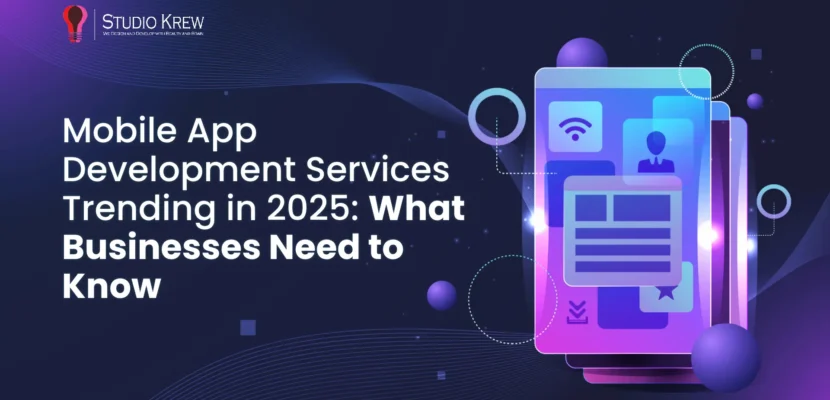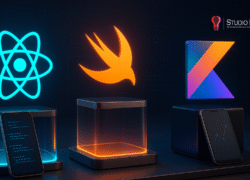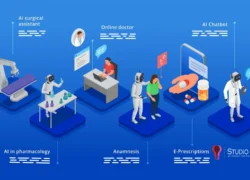In the fast-moving world of tech, mobile app development isn’t just evolving—it’s accelerating. Users expect more than functionality with every tap, swipe, and scroll. They demand intelligence, personalization, and seamless experiences. Whether you’re a startup launching your first MVP, a global enterprise scaling across markets, or a tech enthusiast tracking the pulse of innovation, 2025 is reshaping the mobile landscape in bold new ways.
From AI-native apps that think ahead of user intent to cross-platform app development frameworks that reduce go-to-market time, today’s mobile trends are more than technical upgrades—they’re business enablers. What’s more exciting? Emerging features like on-device machine learning, cloud-native architectures, and gamification layers in non-gaming apps are now setting the stage for smarter, faster, and more emotionally engaging user journeys.
💡 So, what should you expect from the top mobile app development companies in 2025?
Let’s delve into the trends, technologies, and tactical advantages the most forward-thinking app development companies are leveraging in 2025. These are backed by real-world use cases from regions like the USA, UK, South Africa, UAE, and India. These use cases demonstrate the practicality and effectiveness of AI-native apps in various industries and regions.

1. AI-Native Apps Are Leading the Game
The mobile app ecosystem in 2025 is undergoing a profound transformation, thanks to AI-native applications. These are not just apps with added artificial intelligence, but fundamentally built around it. These AI-based mobile apps go beyond standard automation or chatbots. They use machine learning models and real-time data to dynamically change the app’s behaviour, interface, and content, delivering hyper-personalized experiences at scale. The potential of these apps to transform user experiences is truly inspiring.
These applications continuously learn from user behaviour, adapt based on data patterns, and proactively offer solutions even before the user asks. Whether it’s a health app predicting your sleep patterns or a shopping app suggesting the perfect product bundle at the right moment, AI-native apps offer smarter interactions and deeper engagement.
In short, AI is no longer a feature. It’s the core engine that powers next-gen mobile experiences.
How It Should Be Considered from the Business Perspective
From a business angle—whether you’re a startup, enterprise, or product owner—adopting AI-native strategies is not just a trend, it’s a necessity. The competitive edge can set you apart in the fast-paced world of mobile app development. These strategies can significantly enhance customer retention, reduce costs, and position your brand as future-forward and tech-savvy.
Here’s why:
- Customer Retention through App Personalization: Personalized interfaces and offers increase user engagement and reduce churn.
- Faster Decisions, Lower Costs: Predictive analytics help optimize marketing campaigns, resource planning, and customer support.
- Brand Positioning: Offering intelligent experiences positions your app as future-forward and tech-savvy—vital in competitive regions like the USA, UAE, and India.
Engaging a modern mobile app development company specializing in AI-powered mobile application development services can help you architect solutions that deliver ROI and user delight.
Trending About
In 2025 and heading into 2026, AI-native features are expanding across industries:
- Emotion AI (apps that respond to user mood using voice or facial analysis)
- On-device Machine Learning for privacy-first personalization
- AI-powered content creation, especially in education and media
- Hyperlocal recommendations in travel and commerce apps
- AI copilots in productivity and enterprise tools (e.g., scheduling assistants)
- AI-powered in game mechanics and reward mechanics – Explore more at AI-Powered game development company – StudioKrew page.
According to global app intelligence platforms, over 45% of top-performing apps in the USA and UK now embed real-time AI features for personalization, content generation, and user engagement.
Popular Examples
- Spotify: With its AI DJ feature, Spotify creates a dynamic listening experience by blending user history, mood detection, and audio analysis. It’s a perfect example of an AI-based mobile app that learns and evolves with the user, redefining what music personalization looks like.
- Snapchat’s My AI: Snapchat launched an AI chatbot that offers smart replies and tailored suggestions based on conversations. It’s integrated deeply into the app’s ecosystem, giving users a personalized companion powered by generative AI.
These examples show how AI-native mobile apps aren’t limited to niche categories—they’re reshaping social media, entertainment, healthcare, retail, and more.
Also Read: The Comprehensive Guide to Healthcare Application Development
2. On-Device AI for Speed, Privacy & Offline Functionality
As AI becomes the heart of modern apps, another game-changer is taking the spotlight through AI-Powered Application development services: on-device AI. Instead of relying entirely on cloud servers, AI models are now being compressed and optimized to run directly on smartphones, tablets, and wearables, in real time and without internet dependency.
This means your app doesn’t need to ping a server whenever it wants to recognize a face, translate speech, or make predictive decisions. With on-device AI, everything from voice processing to gesture recognition and contextual recommendations can happen locally.
Thanks to processor advances (like Apple’s Neural Engine, Google Tensor, and Qualcomm AI chips), on-device AI is now powerful, battery-efficient, and incredibly fast.
How It Should Be Considered from the Business Perspective
From a business lens, on-device machine learning is a goldmine for three major reasons:
- Faster Response Time: Real-time responsiveness (without network latency) means smoother user experiences, which is crucial for industries like gaming, health, and finance.
- Enhanced Data Privacy: In regions with strict data regulations (like the UK and EU), keeping user data on-device can make compliance easier while building user trust.
- Offline Access = Wider Reach: Offline apps have a clear advantage in markets like India, South Africa, and remote regions of the UAE, where internet access can be spotty. Offline mobile apps powered by on-device AI let users interact, search, or make transactions even when disconnected.
If you’re working with a mobile app development company in 2025, make sure they offer services that include edge AI or device-optimized AI model deployment. It’s the future of mobile intelligence.
Trending About
Heading into 2026, the focus is shifting from cloud dependency to hybrid and fully edge AI models, especially for:
- Face unlock and biometric authentication
- Offline voice translation and voice assistants
- Smart photo editing and object detection
- Activity recognition in fitness and health apps
- Text and document scanning in productivity tools
- AI-Integreated Gaming applications
Google’s ML Kit, Apple’s Core ML, and open-source models like Mistral or Llama 3 enable developers to package once-heavy algorithms into lightweight, device-native applications.
Popular Examples
- Google Lens: A great example of on-device AI, Google Lens can scan and recognize text, objects, landmarks, and even translate languages—all without needing a data connection.
- Apple’s Photos App: Apple uses Core ML to recognize faces, places, and scenes—entirely offline. The user’s photo categorization and search features don’t touch the cloud, making it a benchmark for privacy-first AI-powered mobile apps.
These apps show how real-time, localized intelligence is becoming mainstream—and users are starting to expect this level of performance and privacy by default.
3. On-Device Machine Learning: Speed, Privacy & Offline Power
As AI takes centre stage in mobile experiences, a revolutionary shift is happening in how AI operates within mobile apps. Welcome to the age of on-device machine learning—where intelligent decisions are made right on your smartphone, without pinging cloud servers every second.
In simple terms, on-device ML enables mobile apps to process data, learn from it, and act on it locally. This approach empowers apps to:
- Understand voice commands instantly
- Recognize faces or objects using the phone camera
- Suggest content based on your offline activity
- Keep sensitive data secure—without it ever leaving the device
Unlike traditional cloud-based AI, on-device ML delivers real-time processing, greater reliability in low-connectivity zones, and stronger privacy protection. And it’s not just a technical upgrade—it’s becoming the backbone of next-gen mobile experiences.
How It Should Be Considered from the Business Perspective
For businesses, startups, and enterprises alike, on-device machine learning opens up serious opportunities:
- Faster, Smarter UX: Apps respond instantly, even in flight mode or patchy network areas, creating more immersive and dependable user experiences.
- Global Reach with Local Optimization: In regions like South Africa, where mobile banking is booming in urban and remote areas, offline-first AI is critical to delivering trust and accessibility.
- Data Privacy = Brand Trust: In data-sensitive countries like the UAE, where smart city integrations handle personal and civic data, on-device ML ensures your app complies with regulations while building consumer confidence through privacy-first design.
- Reduced Cloud Dependency = Lower Costs: Less server-side data processing reduces infrastructure costs while improving app responsiveness. It’s a win-win.
If you’re working with a forward-thinking mobile app development company, they should offer AI-powered mobile application development services that prioritize edge-based intelligence for future-readiness.
Trending About
On-device ML is booming across categories and is expected to be a dominant trend well into 2026. Key developments include:
- Neural Processing Units (NPUs) embedded in modern chipsets
- TinyML (ultra-compact AI models) for wearables and IoT
- Offline voice translation in travel and communication apps
- Personalized health coaching apps based on locally stored user data
- In-app smart assistants that don’t need cloud API calls
Leading tech giants like Apple, Google, and Qualcomm are investing heavily in edge AI infrastructure, enabling developers to create apps that are not just smart, but autonomous, fast, and private by design.
Popular Examples
- TymeBank Mobile App – South Africa: In a country where digital financial inclusion is critical, TymeBank’s mobile app leverages on-device ML for secure biometric authentication, even in offline or low-signal zones. It allows rural users to access banking services with speed and privacy, without depending on a constant internet connection.
- DubaiNow Smart City App – UAE: Dubai’s flagship app for smart government services, DubaiNow, uses on-device machine learning for tasks like auto-filling user data, scanning documents, and managing civic tasks with minimal cloud dependency—an essential feature in a country pushing for hyperconnected yet secure smart city solutions.
These examples prove that on-device machine learning isn’t a theoretical innovation—it’s already shaping AI-powered mobile apps that adapt to diverse geographies, industries, and connectivity levels.
Have a application idea which need to be developed but confused how to start? Check our guide to turn your application idea into reality.
4. Super Apps: One App, Many Worlds
Say goodbye to app clutter. In 2025, we’re witnessing the rise of Super Apps—robust digital ecosystems that bundle multiple services into one unified mobile application. From food delivery and payments to grocery, travel, entertainment, and more, super apps are designed to be a one-stop hub for nearly everything users need.
What makes this trend truly disruptive is the blend of convenience, personalization, and cross-service intelligence, all within a single interface. Users no longer want “just a food app” or “just a payment app.” They want experiences that integrate naturally into daily life, without jumping between screens.

How It Should Be Considered from the Business Perspective
For startups and enterprises alike, developing or plugging into a super app ecosystem presents several benefits:
- Increased User Retention: With everything from payments to content living inside one interface, users spend more time in the app, boosting session length, engagement, and lifetime value.
- Cross-Service Upselling: Sell products, offer subscriptions, and launch loyalty programs seamlessly across interconnected features. A fintech product can offer e-learning, and a ride-hailing app can promote entertainment. There are endless combos.
- Brand Ecosystem Control: Rather than being one small service in someone else’s app, you can build your own ecosystem that keeps users coming back for everything.
- Hyper-Personalization Across Services: Thanks to shared user data across modules (ethically handled, of course), businesses can offer deep personalization, from tailored offers to AI-generated recommendations.
- In App Gamifications and Mini-games: In the thrilling world of app gamification, everyone—from investors and COOs to CEOs and founders—is on a quest to supercharge app performance metrics. Imagine harnessing the power of engaging game-like features that not only boost user retention but also skyrocket your daily active user stats! With the right gamification strategies, you can dramatically cut down on uninstalls and keep your users coming back for more. Curiosity piqued? Dive into our blog to discover all the exciting details! How Gamification is a Must for Your Application in 2025
So, if you’re talking with a modern app development company, ask if they specialize in super app architecture and modular mobile app development services.
Trending About
The Super App wave is expanding beyond Asia, finding serious traction in India, UAE, and South Africa, where mobile-first consumers are eager for consolidated digital experiences.
Why it’s trending in 2025:
- Time-strapped users want fewer apps with more functionality.
- Businesses want to retain users by offering more value.
- AI and analytics make cross-service personalization easier than ever.
- Super apps can include payment gateways, loyalty programs, real-time tracking, mini-games, and more in one native flow.
From banking+shopping to ride-hailing+news, this bundling of features will dominate the mobile app development space well into 2026.
Popular Examples
- Swiggy – India: Swiggy started as a food delivery platform but quickly expanded into a full-fledged super app experience. With Swiggy Instamart (grocery and daily essentials), Swiggy Genie (pickup and drop services), and Minis (D2C shopping), users can now order food, buy essentials, run errands, and shop—without leaving the app. This model has become a benchmark for quick commerce and ecosystem-driven mobile app development.
- Careem – UAE: What was once a ride-hailing app now offers food delivery, digital payments, grocery, pharmacy, and even home cleaning services—positioning Careem as a daily lifestyle companion in the Middle East. Their model proves that super apps can succeed when built around deep market localization and trusted services.
Super apps are no longer confined to Asia—they’re scaling globally and redefining what users expect from a mobile app.
5. Voice-Enabled Interfaces: Speak to Experience
We’ve officially moved beyond typing—voice commands are now a mainstream UX expectation. In 2025, voice-enabled mobile apps will redefine accessibility, speed, and convenience across industries. Thanks to rapid advances in natural language processing (NLP) and multilingual voice recognition, users can now interact with apps in real time using voice commands, from shopping and booking to banking and healthcare.
Whether it’s with basic features like “Find song with lyrics…” or AI-based assistance like “reorder my groceries,” “send ₹500 to Rahul,” or “book a 7 PM slot at the salon,” mobile apps are now listening—and acting.
What makes this trend more exciting is the integration of voice AI with AI-based mobile apps, enabling apps to contextually understand, personalize, and respond to voice queries. And in regions with linguistic diversity, voice interfaces aren’t just a convenience—they’re a game-changer for inclusivity.
How It Should Be Considered from the Business Perspective
If you’re a startup building for mass user adoption, or an enterprise investing in scalable mobile app development services, voice integration is no longer optional—it’s strategic.
- Faster and Smoother UX: Voice cuts friction. It helps users complete tasks hands-free, especially in mobile banking, retail, health, and smart home sectors.
- Inclusive Design for All Demographics: From elderly users to semi-literate populations in Tier 2/3 cities (India, South Africa), voice bridges usability gaps and expands your market reach.
- Multi-Language Personalization: Integrating multilingual voice support helps brands build trust and relatability in regional markets (e.g., Hindi, Arabic, Zulu).
- New App Features and Revenue Avenues: Apps can now offer voice commerce, voice ads, AI-based customer support, and voice navigation in super apps, unlocking monetization with better engagement.
If you’re partnering with a leading mobile app development company, ensure they offer voice assistant SDK integration, NLP customization, and speech-to-text capabilities as part of their stack.
Trending About
Voice technology is trending heavily in regions where:
- Hands-free interaction improves efficiency (e.g., smart homes in UAE)
- Digital adoption is mobile-first, but literacy rates vary (e.g., India, South Africa)
- Businesses want to offer hyper-local services with voice-first UX
By 2026, 70% of mobile app sessions in specific industries—especially in the fintech, health, and logistics sectors — are expected to begin with a voice query.
Popular Examples using Voice enabled features in mobile applications
- Amazon Alexa Mobile App – USA & UK What started as a smart speaker assistant has evolved into a mobile powerhouse for voice-based control, letting users manage smart homes, stream media, shop, and even check calendar updates via voice on mobile.
- MyJio App – India: Jio’s flagship app enables users to recharge, pay bills, shop, and stream using multilingual voice commands. It supports several Indian languages, offering voice-first UX for Tier 2 and rural audiences, setting a great example of regionally adapted app development.
6. AR + Spatial Computing Features
Welcome to the era where mobile apps are both interactive and spatially aware.
In 2025, augmented reality (AR) application development services will be more than an innovation—it will be its own medium for real-world interaction. Combined with spatial computing, AR will transform mobile apps from screen-based experiences into environment-aware, real-time interactive journeys.
These apps use your phone’s camera, motion sensors, and AI to understand depth, position, and context, transforming how users engage with their surroundings. The result? Seamless interactions that blend digital experiences with physical space, whether it’s learning, shopping, exploring, or gaming.
In 2024, the global mobile augmented reality (MAR) market was estimated at $11.9 billion. Foreseen to experience significant expansion, it is predicted to reach $13.8 billion in 2025, and over $21 billion by 2028. *Statista

With the rise of spatial SDKs and Lidar-enabled devices, mobile apps can now adapt to your physical environment, creating deeply immersive experiences far beyond traditional UX.
How It Should Be Considered from the Business Perspective
AR and spatial computing aren’t just tech upgrades but strategic business assets. Brands offer tangible ways to engage, educate, and retain users by delivering contextual, visually rich experiences.
From reducing cart abandonment in e-commerce through virtual try-ons to revolutionizing edtech and home entertainment, spatial features elevate apps from tools to lifestyle enablers. For startups, this offers product differentiation. For enterprises, it enables next-level user loyalty and data-rich insights.
AR integration is becoming crucial for user-focused applications across industries as mobile app development services become more personalized and intuitive.
Also Read: Top AR App Development Companies – Covering top ranked AR applications development service provider with their recent works.
Trending About
- Apple’s Vision Pro SDK and ARKit 6 encourage shared spatial experiences with dynamic object rendering and occlusion.
- Google and Niantic’s spatial anchors now support hyper-local AR interactions.
- Brands are investing in multi-user AR experiences, AI-enhanced AR filters, and TV casting for shared spatial engagement.
These advances are fueling demand for spatial-first app development, especially among forward-thinking mobile app development companies targeting immersive consumer experiences.
Popular Examples for AR and Spatial Computing features
- IKEA Place – One of the earliest pioneers in spatial AR, IKEA allows users to place furniture in their homes with accurate scaling and positioning, bridging the gap between physical shopping and digital convenience.
- Party Blaster (by StudioKrew) – A hybrid AR mobile game that lets kids physically play and interact in front of a mobile device while casting the game to a smart TV. Designed for family-friendly gameplay, cognitive learning, and social interaction, Party Blaster introduces real-time AR reactions, gesture-based input, and a shared living-room experience. A perfect case of how spatial computing and entertainment merge for playful learning.

Wrapping Up: The Future Is Already Here—Is Your App Ready?
The mobile app development landscape in 2025 isn’t just evolving—it’s accelerating into a future shaped by AI, AR, personalization, and intelligence at the edge. As we’ve explored throughout this blog, the apps of tomorrow will not only predict behavior but respond in real time, blend physical and digital realities, and scale seamlessly across platforms and regions.
Whether you’re a startup founder seeking the next big idea, a large enterprise digitizing operations, or a tech enthusiast tracking the latest trends, one thing is clear—mobile apps are no longer just tools; they’re experiences.
To succeed in this competitive ecosystem, it is critical to partner with the right mobile app development company that understands emerging tech and user psychology. This means choosing a team that doesn’t just code but co-creates scalable, intelligent, and human-centric solutions.

At StudioKrew, we’re proud to build that future across the USA, UK, South Africa, UAE, India, and beyond.
Ready to Ride the Wave of Innovation?
Whether you’re exploring AI-native apps and cross-platform 2.0 architectures or want to gamify your non-gaming platform, now’s the perfect time to act. Let your app stand out with sleek design, intelligence, adaptability, and purpose.

Reach out to a team that lives and breaths innovation in mobile app development services.





